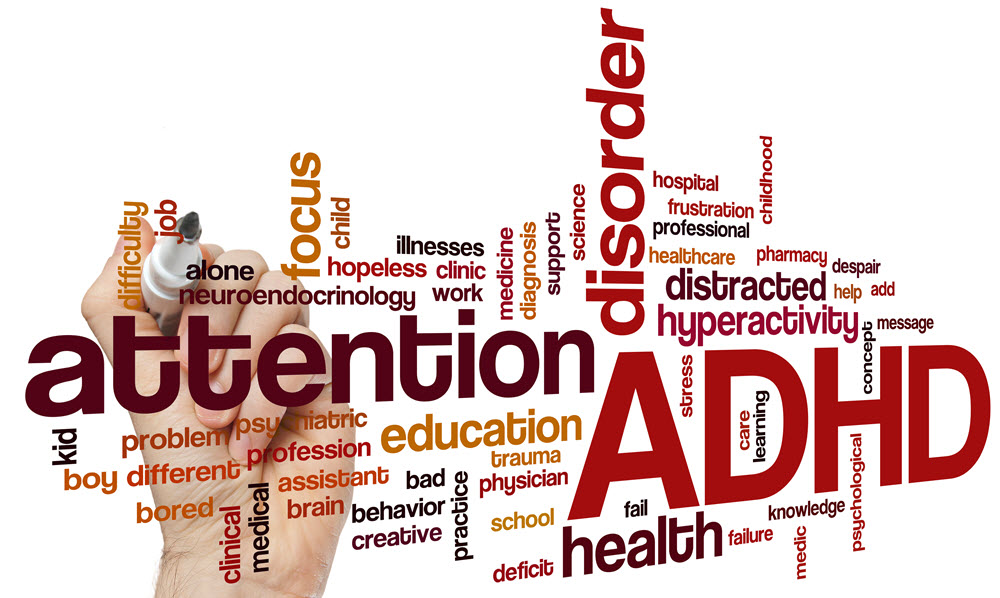
Attention-Deficit/Hyperactivity Disorder
The current term, ADHD, came into use in 1994, and replaced “Attention Deficit Disorder (ADD).” Many people continue to use ADD, probably because it’s easier to remember and to say. In addition, many people mistakenly think that if you are diagnosed with ADHD, you must be “hyperactive”—not true. Actually, the “/” in Attention-Deficit/Hyperactivity Disorder means “or,” so ADHD indicates an individual with attention-deficit, or hyperactivity, or both. Further, we currently recognize three subtypes of ADHD—predominantly inattentive, hyperactive-impulsive, and the combination of those two.
PREVALENCE
Estimates vary slightly, but most experts agree that ADHD occurs in about 5-11% of school age children,1 and remains in about 5% of adults.2 For children, the ratio of males to females is about 3:1, but with adults it drops to about 2:1, still in favor of males. We think ADHD is primarily a biological disorder of brain functioning that is often passed on genetically from parent to child.
SYMPTOMS
The diagnosis of ADHD is strongly suspected when an individual experiences a sufficient number of the following symptoms:
- Fails to give close attention to details or makes careless mistakes.
- Has difficulty sustaining attention.
- Does not appear to listen.
- Struggles to follow through on instructions.
- Has difficulty with organization.
- Avoids or dislikes tasks requiring a lot of thinking
- Loses things.
- Is easily distracted.
- Is forgetful in daily activities.
- Fidgets with hands or feet or squirms in chair.
- Has difficulty remaining seated.
- Runs about or climbs excessively in children; extreme restlessness in adults.
- Difficulty engaging in activities quietly.
- Acts as if driven by a motor; adults often feel this way inside.
- Talks excessively.
- Blurts out answers before questions have been completed.
- Difficulty waiting or taking turns.
- Interrupts or intrudes upon others.
Children or adults who have five or more of the above symptoms qualify for the diagnosis.3
TESTING FOR ADHD
There are no medical or blood tests for ADHD. Fortunately, psychologists do have a number of tests they can give to help diagnose this disorder. These include IQ, academic, and neuropsychological tests of working memory, focusing, and executive functioning, rating scales where the subject is statistically compared to ratings of groups of individuals the same age and gender, and computerized tests of the ability to sustain attention over a period of about 20 minutes. We use the results of all these tests together to make the best possible determination if ADHD is present or not, and to what degree of severity.
In compliance with the American Disabilities Act (ADA), individuals diagnosed with ADHD are eligible for accommodations in several life areas, most importantly in the areas of school and work. With sufficient documentation through psychological testing, students at any academic level with ADHD routinely receive accommodations which can include:
- additional time on examinations—school-based tests as well as nationally standardized tests such as the SAT, LSAT, MCAT, GRE, GMAT, and state Bar Association examinations),
- the opportunity to take examinations in a quiet, private setting,
- additional time for classwork, homework, and projects,
- faculty-prepared lecture notes, the use of recording devices in lectures, and
- tutoring in subjects where needed.
TREATMENTS
As with any psychological disorder, there is no guaranteed fool-proof single method of treatment that works well with everyone. Nonetheless, there are some frequently used treatments that have worked well for most individuals.
First, there is an exciting new computer-based program which involve repeated practice using online software designed to improve working memory. This program, Cogmed Working Memory Training, is the most research-based intervention available for improved attention. Patients engage in 30-50 minutes of online daily practice while at home for a total of five weeks. Progress is closely monitored by the psychologist. Cogmed Working Memory Training allows you to focus and resist distractions better. This will help you academically, socially, and professionally. Cogmed is based on peer-reviewed, published research by leading scientists. No other attention training products can match the research base behind Cogmed. Read more about Cogmed here.
Second, it works best for parents and adult patients to engage in a cognitive behavior therapy approach to encourage greater motivation on the part of the patient to try to better control their symptoms of ADHD. This can include parents using a system of rewards and consequences—designed with the help of the psychologist—which will help the child stay on task more and strive to be better organized in their approach to school work and daily activities. Adult patients themselves work with the psychologist to construct specific methods of improving their organizational skills and coping strategies to better manage their symptoms of ADHD.
The third method is well-known, and involves the use of medication. There are three categories of these drugs—stimulants (brand names Ritalin, Adderall, Vyvanse, and others), all of which target the brain transmitters dopamine and norepinephrine; atomoxetine (brand name Strattera), which broadly targets norepinephrine; and guanfacine (brand name Intuniv), which targets primarily norepinephrine in more specific brain areas. Once the diagnosis is confirmed and medication is agreed upon as the option of choice, a referral is made to a competently trained physician—usually a child psychiatrist, pediatric neurologist, or pediatrician—who will prescribe the medicine they think will work best. They then supervise the patient taking it on a “trial basis,” this, because there is no fool-proof way to know exactly which medicine will work with which patient, and at which dose. These medication trials take place over the next several weeks, until the optimal medicine and dose are determined.
Contact Dr. Tom Bonner today to get expert help for ADHD.
REFERENCES (for further reading)
1Centers for Disease Control and Prevention (2013, November 13). Attention-Deficit / Hyperactivity Disorder (ADHD). Retrieved from http://www.cdc.gov/ncbddd/adhd/data.html.
2Barkley, R.A., Murphy, K.R., & Fischer, M. (2008). ADHD in Adults: What the Science Says. New York: Guilford Press.
3American Psychiatric Association (2013). Diagnostic and Statistical Manual of Mental Disorders, Fifth Edition: DSM-5. Washington: American Psychiatric Association.
